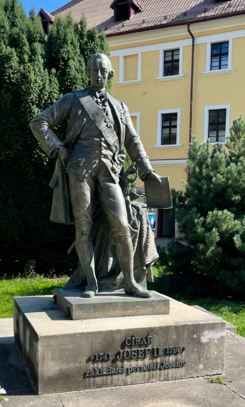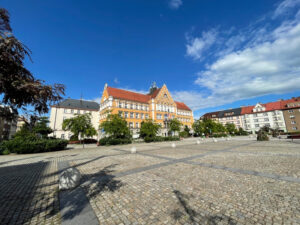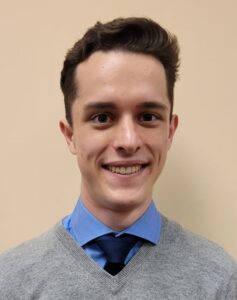History in Our World
A Tar Heel in Bohemia

UNC History Ph.D Student Kevin Hoeper had an exciting journey to Czechia, where he attended a conference entitled: “Army, Society, and Warfare in the Bohemian Lands under the Habsburgs (1526-1918).” This conference was organized by an interdisciplinary team of European scholars working on different eras of Habsburg military history, focusing on what is modern-day Czechia. Kevin’s scholarship examines the history of the regiment in Habsburg service: “From the birth of the Habsburg standing army until its dissolution in 1918, the regiment was the army’s most basic administrative structure and the center of military life for soldiers and officers. It is thus an exceptional analytical lens through which to observe continuities and ruptures in Habsburg military culture across the centuries.”
At this conference, Kevin was able to communicate with scholars of different backgrounds: “One of the main impulses behind the conference was to transcend the temporal and thematic barriers that tend to silo scholars in the field of Habsburg and Bohemian military history. There is robust scholarship on the early-modern period, Napoleonic era, and modern period, but I get the sense that these scholars don’t always talk to each other. There are also often thematic barriers between those who pursue more ‘traditional’ military history (focused on wars, battles, campaigns, logistics, tactics, etc.) and those who take a more social- or cultural-historical approach. The organizers” Kevin states “did an excellent job of constructing a program that represented all of these myriad focuses and approaches.”
The topics of the different panels reflected this effort to challenge researchers’ paradigms. “Each was centered around a specific theme — many of them quite creative — that encouraged the audience to see the common scholarly concerns that connect our temporal subfields. For example, a panel on “New Archival Case Studies” included three talks: one each dealing with the late 17th century, the Napoleonic wars, and the First World War.”
This meeting, moreover, introduced Kevin to different ways of conceptualizing his research: “While my work focuses primarily on the modern period (think 19th century to World War I, as well as the post-1918 Habsburg successor states), I have by necessity needed to engage with scholarship on the regiment’s role in earlier periods. By allowing me to interact with historians who specialize in these earlier periods, the conference gave me a far greater appreciation for the questions, concerns, and challenges that shape those subfields. I was also able to ask a few technical questions about early-modern and Napoleonic-era Habsburg regiments that are relevant to my own arguments.”

Kevin also enjoyed the conference’s location in the Czech city of Pardubice, located about an hour east of Prague. “Earlier, during my research year in 2019-20, I had been able to visit some three dozen towns and cities across the Czech Republic but had not visited Pardubice. Part of the conference program included a guided historical tour through the old town, during which we were treated to the city’s many late medieval, renaissance, and Baroque landmarks. Pardubice’s crown jewel is of course its castle. Built in stages from the 13th century by the Pernštejn family, the castle is intimately connected with the pre-Habsburg history of the Bohemian lands. The conference panels actually took place each day in the castle’s great hall; listening to brilliant scholars teach me about their work in the central hall of a beautifully maintained castle is an experience I will never forget.”
“After two days of panels at Pardubice castle,” Kevin explains “the third and final day of panels took place about an hour away, at the eighteenth-century fortress of Josefov (Josephstadt).” This picturesque location was connected, in fact, to some of the topics discussed at the conference. “There, in a room hung with paintings of Habsburg dynasts and Bohemian nobles, conference attendees were treated to presentations on the memory of the 1683 Siege of Vienna and the fate of Bohemia’s medieval castles after the Thirty Years War. We concluded the day with a guided tour of the fortress itself, during which several of the conference attendees volunteered additional information about the fortifications based on their own specialist research. “It was,” Kevin recalls “another priceless experience.”
The organizers of the conference made a great effort to recruit scholars from many countries and differing professional fields. “There were many scholars from the Czech Republic of course, but also scholars from Serbia, Hungary, Austria, Germany, and one — myself — from the United States. There were women and men, historians and literary specialists, well-established authors, and early-career graduate students. There was also a fascinating mix of institutional affiliations, including museums, universities, and research institutes. This latter aspect gave me new insight into the diverse research “ecosystem” that structures my field.”
“On the whole,” Kevin explained, “meeting this group of researchers and engaging with their work made me feel more connected to my field. It also introduced me to potential collaborators, several of whom have already generously provided me with tips on relevant primary sources.” Kevin’s travel was funded by a UNC Graduate School Transportation Grant. “This was a truly exceptional conference, and I owe an immense debt of gratitude to the UNC Graduate School and UNC History Department staff who helped get me there.” “All in all,” Kevin states, “this for me was the model of what a small, specialist conference can and should look like. I learned a lot, met great scholars, presented some of my own research, and left feeling more connected to — and motivated about — my field of study.”

Nationalism and the Power Grid

Zora Piskačová is a 5th-year Ph.D student in history at UNC Chapel Hill, where she studies interwar East-Central European history. In November of 2022, she received the Association of Slavic, Eurasian, and Eastern European Studies Beth Holmgren Graduate Student Essay Prize for her piece “A ‘Common Enterprise?’: The Role of Utility Infrastructures in the Divided City of Teschen, 1920-1938.” This year, she won the Anthony Jung Award for Best Graduate Student Paper for the European Studies Conference held at the University of Nebraska Omaha.
Zora’s research connects back to her own family’s history: “My mother’s parents came from a town called Orlová in Czech Silesia – a town some 15 miles north-west from Český Těšín. My grandfather Václav was born in 1921, my grandmother in 1934. They both lived in this region which bordered Poland most of their lives. My grandfather was a self-taught intellectual. He read everything imaginable, played chess and guitar, and knew something about everything. He loved the region he came from and even wrote a chronicle of the mine he administered in his old age.”
While working on her project, Zora rediscovered some of these ties: “When I went to the local archive that houses the municipal records of Český Těšín – Státní Okresní Archív in Karvina – it turned out the archivist remembered my grandfather, who came there to do research for his chronicle more than a decade prior. I knew he loved the region and never quite managed to let it go, despite his move to the capital. It was touching, somehow, to reconnect with this place that meant so much to him, but that I was never really part of.”
Zora studies the division of the multiethnic Habsburg city of Teschen into Polish Cieszyn and Czech Český Těšín in the period between the First and Second World Wars. Before 1918, Teschen was the capital of the Dutchy of Teschen in Upper Silesia. Following the First World War and the fall of the Austrian-Hungarian Empire, the new states of Poland and Czechoslovakia sought to control it: “Poland claimed it based on ethnic grounds; Czechoslovakia argued the local railway junction was necessary for its survival as it connected its Czech lands with Slovakia. The two states clashed over the region in a week-long war and the period which followed and was supposed to be ended by a plebiscite saw a rise of nationalist fervor and violence as both sides and the German loyalists tried to sway the local population in their favor. To avoid further escalations the Allied Powers decided to split the region in half and severed its capital in the process creating two towns out of one.”
This political solution did not account for the physical infrastructure necessary for the running of a modern city, Zora explains: “The towns shared not only a hospital but also a power plant, a gasworks and one water supply network all of which could not be easily duplicated.” The locals, however, were able to cooperate and solve these problems: “They ran a shared ambulance service for a time, cooperated to suppress petty crime, and encouraged a close cross-border relationship between the two municipal fire brigades to shield their urbanites from fire hazards. My dissertation is therefore about the men, and yes, they were 99% men, who tried to make their divided city go on without too much disruption. To achieve this, they also compromised within their individual municipal assemblies as the town did not consist of just Poles and Czechs, there were Germans, Jews, and a group that identified as Silesians. Local administrators that made such daily life possible were therefore more than vicious perpetrators of violence, mindless nationalists, or obedient servants of their national governments.” “Nationalism,” Zora argues “was not always the determining factor. They were pragmatic actors who defended their constituents sometimes against the wishes of their respective governments.”

Zora recognizes that her findings may seem surprising to many. “When people ask me what I’m writing about, and I want to make a joke I say: ‘Municipal administrators doing their jobs.’ It’s boring because it’s so mundane. They mostly talk about trash collection, argue about municipal budgets, and try to get everyone in the town enough running water, and yet I think that while large questions of nationalism were important this research shows that life goes on and men were able to compartmentalize their interest. These men were not indifferent to nationalism of course. They had to ‘pick’ a nationality because they had to run for election in a system that necessitated it. Some of them were even ardent nationalists. Holding speeches and rallying men and women against the ‘other’ side and yet they were still very much able to sit at the same table with men who did not share their views, men they often actively fought against during the hot period of the conflict in 1919-1920 and still come to a compromise. The basic interest of the constituents topped in most cases all kinds of ideology and while the period ended in bloodshed, this was by and large a top-down decision that people bought into but did not necessarily instigate.”
In developing this project, Zora has also come across stories that have surprised her: “Doing research on the interwar period, I knew oral history won’t be an option as most first-hand witnesses were long gone. I also never imagined I’d meet someone who would actively remember the time I was writing about. But I was wrong.” In 2022, after presenting her research at a German conference on Silesia, she received a typewritten letter from Dr. Herbert Patzelt: “Dr. Patzelt had read about my presentation and expressed interest in my work on Teschen as he had been born there in 1925 and as a German-speaker forcefully expelled in 1938 following the Munich Agreement. I sent him the little I had written, at the time and he sent me back a thick package featuring copies of pictures of his family, the town of Český Těšín, and even his school report. He also included a short memoir he has written about his childhood in the town that I was previously unaware of. Sadly, I did not have a chance to reply to this wonderful compilation which spoke of his love for the place he had to vacate as Dr. Patzelt passed away shortly after sending the letter to me. As historians, we don’t always get to have this kind of interaction.”
Zora’s work seeks to add nuance to our understanding of a region that has often been defined by competing nationalisms and inter-ethnic violence. “This is a unique case of course that owes a lot to practices of tolerance inherited from the imperial era as well as the fact that the town wasn’t ethnically segregated.” She continues: “In that sense, I would argue that what we see here is that behind all the literature on war hide other stories – stories that are perhaps less exciting and that do not make it to the newspapers but no less true. To understand how we got where we are, how conflict happens, and how to perhaps prevent it, we need to learn about these ‘mundane’ stories too.”

Simulating the Cuban Missile Crisis with Dr. Morgan

The Cuban Missile Crisis was a major event in the Cold War, and it has also become a great teaching opportunity for Dr. Michael Morgan’s course, The Global Cold War. With a grant provided by the Office of the Vice Provost for Global Affairs, Dr. Morgan introduced a simulation project into the course that gave students real-time experience with the difficult decision-making processes taking place behind the scenes during the major historical events students learned about. The grant gave Dr. Morgan access to funds to purchase the material needed for the simulation and to a graduate student teaching assistants, Mark Thomas-Patterson.
Thomas-Patterson, a Ph.D. student of Dr. Morgan who studies Cold War history focusing on U.S. arms control and U.S. Soviet relations in the 1990s, would prove a cornerstone of the effort to make a viable simulation for the History 207 class. For the design of the game itself, Mark drew significantly on the book Can you Beat Churchill? by Michael Barnhart and consultations with friends who had designed similar events. According to Mark, one of the biggest challenges was the chronological framework. “This simulation lasted around fifty minutes…and this became a challenge.” Part of the solution was to assign roles and research a week before the simulation so that students could prepare and time explaining the game during the stimulation could be kept to a minimum. Mark was also invaluable in doing the necessary historical research. This included finding information such as the number, type, and positions of both the Soviet and U.S. military assets in October 1962 and finding primary sources to use in the simulation itself.
All of this work done by Dr. Morgan and Thomas-Patterson built up to the simulations themselves. Each of the six recitations conducted their own simulation, but they all follow this pattern. The simulations started two weeks before the event, with the students reading the book Nuclear Folly by Serhii Plokhy, which provides an international view of the Cuban Missile Crisis. On the event day, the students were divided into groups. Each group represented the U.S., the Soviets, and the Cubans. The students were physically separated and could only communicate with each other through written correspondence. This was done to simulate the fact that the governments could not easily communicate during the actual crisis. With the students separated the game began.
The 50-minute class meetings were divided into five segments, each eight minutes long. Each segment represented three days during the crisis. During this period, the students would have to use the information provided by the “gamemaster” (Mark), and plan a response based on a list of options given to each team. Mark would read the responses and decide what happened, and then the students would use the next segment to react to the new developments. This type of simulation encouraged the students to respond based on how they think their character would act, not to recreate the Cuban Missile Crisis. This led to a variety of outcomes. In one case, the American and Soviet governments attacked each other with a small number of nuclear weapons. However, all students avoided the worst outcome of a full-blown nuclear war.
This stimulation provided a learning opportunity for all involved. allowed the simulation to convey the stresses of decision-making in an international crisis, and it allowed the students to “interact in a confused information environment…this element of the incomplete information environment made this simulation a lot more fun and scary.”
A student who took part in this simulation, Kevin Murphy, said of the experience: “You understand the decision-making processes and what was effective in communication, what was effective in decision-making and how can you adjust that to different situations.”
Dr. Morgan felt one of the most important lessons was historical imagination and empathy. “The goal of the history department is not to turn every student into a professional historian,” he said. “Rather, the idea is to help them grapple with historical imagination’s intellectual and emotional challenges. Empathy is an absolute prerequisite for succeeding in any environment where you are dealing with people who don’t think the way you do—which is to say just about everywhere.”
Gifts to the History Department
The History Department is a lively center for historical education and research. Although we are deeply committed to our mission as a public institution, our “margin of excellence” depends on generous private donations. At the present time, the department is particularly eager to improve the funding and fellowships for graduate students.
Your donations are used to send graduate students to professional conferences, support innovative student research, bring visiting speakers to campus, and expand other activities that enhance the department’s intellectual community.
 |
To make a secure gift online, please click “Give Now” above.
The Department also receives tax-deductible donations through the Arts and Sciences Foundation at UNC-Chapel Hill. Please note in the “memo” section of your check that your gift is intended for the History Department. Donations should be sent to the following address:
UNC-Arts & Sciences Foundation
Buchan House
523 E. Franklin Street
Chapel Hill, NC 27514
Attention: Ronda Manuel
For more information about creating scholarships, fellowships, and professorships in the Department through a gift, pledge, or planned gift please contact Ronda Manuel, Associate Director of Development at the Arts and Sciences Foundation: ronda.manuel@unc.edu or (919) 962-7266.
